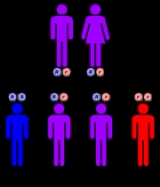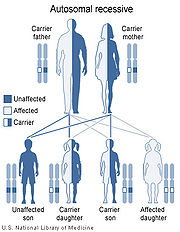
Cerebrotendineous xanthomatosis
Encyclopedia
Cerebrotendineous xanthomatosis or cerebrotendinous xanthomatosis (CTX), also called cerebral cholesterosis, is an autosomal
recessive form of xanthomatosis.
(cholestanol) in the brain and other tissues and with elevated levels of cholesterol in plasma but with normal total cholesterol level; it is characterized by progressive cerebellar ataxia
beginning after puberty and by juvenile cataract
s, and tendineous or tuberous xanthoma
s.
 CTX is associated with mutation
CTX is associated with mutation
s in the CYP27A1
gene, located on chromosome
2q33-qter
. The disorder is inherited in an autosomal recessive manner. This means the defective gene responsible for the disorder is located on an autosome
(chromosome 2 is an autosome), and two copies of the defective gene (one inherited from each parent) are required in order to be born with the disorder. The parents of an individual with an autosomal recessive disorder both carry
one copy of the defective gene, but usually do not experience any signs or symptoms of the disorder.
("statins" such as simvastatin
) can also be used.
Autosome
An autosome is a chromosome that is not a sex chromosome, or allosome; that is to say, there is an equal number of copies of the chromosome in males and females. For example, in humans, there are 22 pairs of autosomes. In addition to autosomes, there are sex chromosomes, to be specific: X and Y...
recessive form of xanthomatosis.
Characteristics
An inherited disorder associated with the deposition of a form of cholesterolCholesterol
Cholesterol is a complex isoprenoid. Specifically, it is a waxy steroid of fat that is produced in the liver or intestines. It is used to produce hormones and cell membranes and is transported in the blood plasma of all mammals. It is an essential structural component of mammalian cell membranes...
(cholestanol) in the brain and other tissues and with elevated levels of cholesterol in plasma but with normal total cholesterol level; it is characterized by progressive cerebellar ataxia
Ataxia
Ataxia is a neurological sign and symptom that consists of gross lack of coordination of muscle movements. Ataxia is a non-specific clinical manifestation implying dysfunction of the parts of the nervous system that coordinate movement, such as the cerebellum...
beginning after puberty and by juvenile cataract
Cataract
A cataract is a clouding that develops in the crystalline lens of the eye or in its envelope, varying in degree from slight to complete opacity and obstructing the passage of light...
s, and tendineous or tuberous xanthoma
Xanthoma
A xanthoma , from Greek xanthos, ξανθος, "yellow", is a deposition of yellowish cholesterol-rich material in tendons or other body parts in various disease states...
s.
Cause and Genetics

Mutation
In molecular biology and genetics, mutations are changes in a genomic sequence: the DNA sequence of a cell's genome or the DNA or RNA sequence of a virus. They can be defined as sudden and spontaneous changes in the cell. Mutations are caused by radiation, viruses, transposons and mutagenic...
s in the CYP27A1
CYP27A1
CYP27A1 is a gene encoding a cytochrome P450 oxidase, and is commonly known as sterol 27-hydroxylase. This enzyme is located in many different tissues where it is found within the mitochondria. It is most prominently involved in the biosynthesis of bile acids.-Function:CYP27A1 participates in the...
gene, located on chromosome
Chromosome
A chromosome is an organized structure of DNA and protein found in cells. It is a single piece of coiled DNA containing many genes, regulatory elements and other nucleotide sequences. Chromosomes also contain DNA-bound proteins, which serve to package the DNA and control its functions.Chromosomes...
2q33-qter
Chromosome 2 (human)
Chromosome 2 is one of the 23 pairs of chromosomes in humans. People normally have two copies of this chromosome. Chromosome 2 is the second largest human chromosome, spanning more than 237 million base pairs and representing almost 8% of the total DNA in cells.Identifying genes on each...
. The disorder is inherited in an autosomal recessive manner. This means the defective gene responsible for the disorder is located on an autosome
Autosome
An autosome is a chromosome that is not a sex chromosome, or allosome; that is to say, there is an equal number of copies of the chromosome in males and females. For example, in humans, there are 22 pairs of autosomes. In addition to autosomes, there are sex chromosomes, to be specific: X and Y...
(chromosome 2 is an autosome), and two copies of the defective gene (one inherited from each parent) are required in order to be born with the disorder. The parents of an individual with an autosomal recessive disorder both carry
Genetic carrier
A genetic carrier , is a person or other organism that has inherited a genetic trait or mutation, but who does not display that trait or show symptoms of the disease. They are, however, able to pass the gene onto their offspring, who may then express the gene...
one copy of the defective gene, but usually do not experience any signs or symptoms of the disorder.
Treatment
The standard treatment is chenodeoxycholic acid (CDCA) replacement therapy. Serum cholesterol levels are also followed. If hypercholesterolemia is not controlled with CDCA, an HMG-CoA reductase inhibitorStatin
Statins are a class of drugs used to lower cholesterol levels by inhibiting the enzyme HMG-CoA reductase, which plays a central role in the production of cholesterol in the liver. Increased cholesterol levels have been associated with cardiovascular diseases, and statins are therefore used in the...
("statins" such as simvastatin
Simvastatin
Simvastatin is a hypolipidemic drug used to control elevated cholesterol, or hypercholesterolemia. Simvastatin is a member of the statin class of pharmaceuticals, is a synthetic derivate of a fermentation product of Aspergillus terreus.-Medical uses:The primary uses of simvastatin is for the...
) can also be used.

